Everyone goes to Jordan to see Petra, and so did I. Everything else on the itinerary was a bonus, but only till I landed in Jerash. An ancient Greco-Roman city located some 50 km north of Amman became my muse. And my benchmark for the rest of the Jordan trip. I was mesmerized by this beautiful city in stone. All that I had ever known about Roman architecture was right in front of my eyes. Even though we visited Jerash on a particularly harsh day with the sun shining on top of our heads, our bodies got dehydrated.
But it still left an everlasting impact on me. I wish I can go back on a pleasant morning or evening and talk to those ancient stones to my heart’s content.
Jerash City, Jordan
Let me just walk you through this ancient city that was at its peak about 2000 years back. Although archaeologists tell me that this place has been continuously inhabited for more than 6500 years. It is not hard to believe it as Jerash lies in a hilly wooded area that is fertile and good for settlements. A general of Alexander the Great first established this city. It is said to be the best-preserved Roman ruins outside of Rome. Since I am yet to go to Rome, this was a real treat for me.
It was a thriving city until the Persian invasion in the 7th CE. After which it fell from its glory and suffered a major earthquake in 8th CE that almost served as the last blow.
Discovery of Jerash
A German traveler Ulrich Jasper Seetzen rediscovered Jerash in 1806. The official excavation and restoration work started in the 1920s and continues to date. As I walked around its well-defined city areas, I wondered how it would have looked in its hay days. When chariots would be running around, people would be moving around – a feeling that I get every time I visit the ruins of Hampi or Nalanda.
There are some parts of the Roman theatre that are well preserved while there are others like the baths on the sides of the walkway called Cardo. There are piles of stones that are still waiting for restoration. Some of them proudly show their well-sculpted sides.
Gerasa
Jerash was originally called Gerasa which comes from the root word Gera meaning Old. Remember geriatric care refers to care for old people. Coincidental that even in Sanskrit Jara means old. I did read somewhere that it was a city built for the old retired soldiers. The city despite being ancient did not feel old to me. In fact, I felt it was a very young city. Not sure where that feeling came from, but at no point, I felt only old people lived here.
Maybe because of the temple of Nymphaeum here, maybe because of its topography that goes up and down. Maybe because of the theatres that indicate a deep interest in life, maybe all of this is put together.
Experts can point out the Greek remains beneath the Roman city. But I could not make out any of those differences. Let me just walk you through the main elements of the city of Jerash.
Hadrian’s Arch
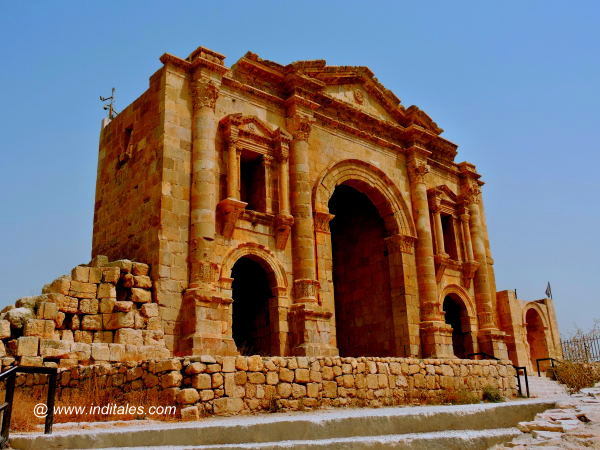
We started walking towards the tall standing gateway with three arches and central arch being the tallest, passing by a wall with arched columns. This today is the entrance to the archaeological site of Jerash. But it was a gate erected to commemorate the visit of Emperor Hadrian in the 2nd CE. The carvings on the top of this arch reminded me of many carvings I have seen at temples in North India. I am not sure which way the influence flow was.
A huge stone with inscriptions lay on the other side of this arch. But whatever was written on it was all Greek and Latin for me 🙂
Between this arch and the main gate of Jerash city lies a Necropolis. This according to our guide was an indication that the city did not extend to Hadrian’s arch as the graves in Roman cities were always outside the city gates.
Hippodrome aka Circus

Hippo means horses and this is a ground for horse racing with an arrangement to seat up to 17,000 spectators. Imagine, how it would be to sit in lovely surroundings and watch horses race and I assume other sports as well. The longish space with tiered seating gives a glimpse of the knowledge of engineering that the people had then. And the aptitude to apply it aesthetically.
With 265 meters in length and 50 meters in width, Hippodrome at Jerash is supposed to be the smallest of all Hippodromes in the Roman Empire. But this one is the best preserved of all. The Caceres or the stone arches where the horses would be positioned at the beginning of the race are worth noting. Built in 3rd CE, it is not known if horse races actually took place here or not. But the theatre used for gladiator fights in 4th CE is well recorded. After the Persian invasion, the material from this site was taken for construction elsewhere. And the final jolt to this structure, of course, came with the 749 CE earthquake.
Today, Jordan Tourism organizes a mock chariot race and a show to re-create that era. We could not see this show as it happens at designated hours. But whoever has seen it recommends it highly. Read more about the show at Roman Army and Chariot Experience Site.
The Church of Mariano built in 570 CE is a remnant from the Byzantine era built on the ruins of Hippodrome. Some mosaic work geometric patterns can be seen here.
South Gate of the City

The gate to the city, past the visitor center, is similar in architecture to Hadrian’s Arch except that its upper part is completely lost. All you can see are similar three arches with a tall central arch. This would be the South Gate of the city. The gate that connected Jerash to Philadelphia or current-day Amman.
Jerash was a part of Decapolis or the group of 10 cities in the eastern front of the Roman Empire:
- Jerash or Gerasa (Jordan)
- Hippos (Israel)
- Gadara or Umm Qais (Jordan)
- Philadelphia or Amman (Jordan)
- Scythopolis or Beth-Shean (Israel)
- Pell (Jordan)
- Capitolias or Beit Ras (Jordan)
- Canatha or Qanawat (Syria)
- Raphana (Jordan)
- Damascus (Syria)
Now that gives me another list to design my travels.
As soon as you enter the gate, you see the ruins of an ancient Souk or a marketplace, or a workshop of artists who served the city.
Roman or South Theater

There are two theatres in the city of Jerash and this one in the South is better preserved. A true Roman amphitheater with a seat in the center to seat the royal family is a delight to watch. It is like any modern theatre but without a roof. Bang in the middle of the stage there is a point where when you stand and speak. You hear your own echo and that tells you about the acoustic quality of this theatre. Literature also tells me that from this point whatever is spoken can be heard across the theatre equally.
Video of Music of Jordan
Watch the video of the music of Jordan.
A two-person band with a bagpiper plays for a few minutes as and when the tourists arrive here. It is the closest you can get to the ancient theater experience today. How wonderful it would be to make these places come alive with modern performances when the weather permits. How magnificent it would be to watch period dramas here!
Temple of Zeus
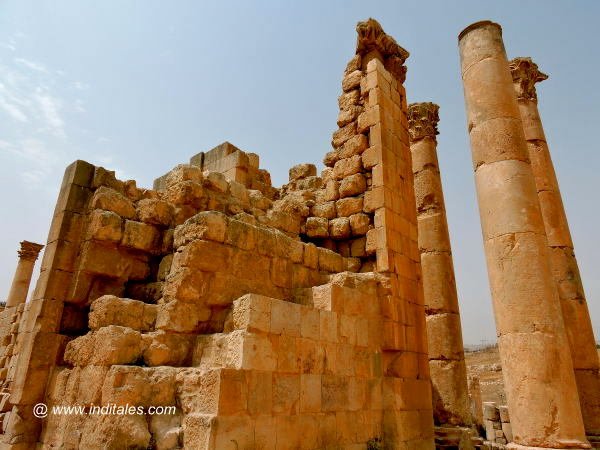
Temple of Zeus Olympios is nothing but ruins of columns today but it stands at a vantage point. It is from here that you can see the whole city and especially the whole expanse of Oval Forum or Oval Plaza. Located on a high point, you can see the whole city in perspective. I wonder if the site of the temple of Zeus was chosen so that the deity can overlook the whole city or vice-versa.
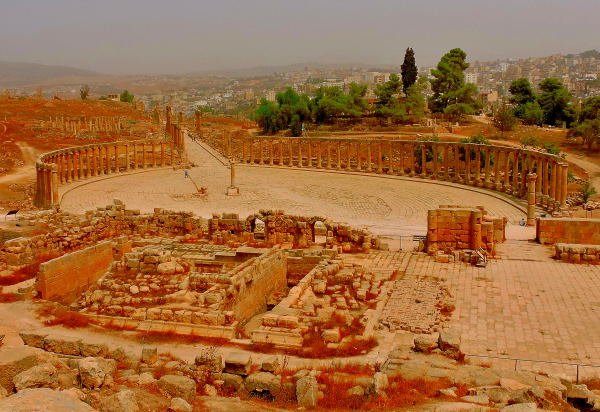
The façade of the temple has eight Corinthian columns. These columns are believed to oscillate when hit – pretty much like our Jhoolta Minar in Ahmedabad. I could not test it, however, the columns look beautiful in sandstone carrying a hint of Onion Pink color.
Though the temple of Zeus is the biggest in this heritage place, it is Artemis who is the patron goddess of the city of Gerasa. Her temple is also on the site though I could not visit it for want of time and hydration.
Oval Forum in the heritage city of Jerash

The Oval Forum is a wide-open space bound by a series of columns making it look like an open stage or a space for gatherings. The Ionic and Corinthian pillars create an ambiance that seems just perfect for the gatherings. The spread-out pillars bind the space in a unique way. They define the space without enclosing it, they set the boundary without obstructing the flow. In the middle stands a new stone pillar that has just been added for the Jerash festival.
Cardo
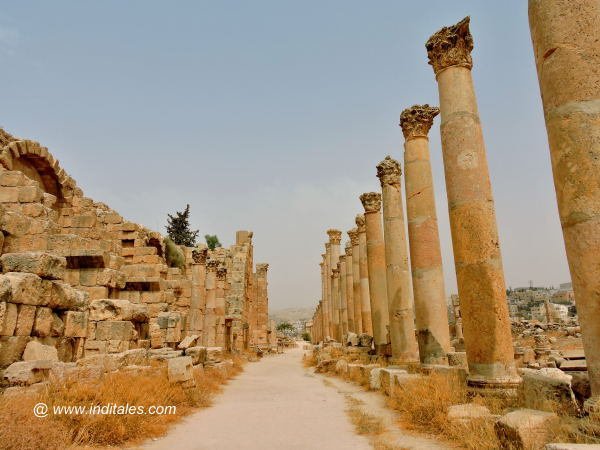
Do you know Cardo means heart? And in the heritage city, Cardo refers to the central street that is flanked by tall columns on both sides and punctuated with lovely temples. The grooves left by chariot wheels can still be seen on its path. It connects the temple of Zeus to the North gate. And covers the 800 meters between Oval Forum and the North Gate. One can only imagine how alive this place would have been.
Columns lining the Cardo give it a tall frame adding elegance to what may otherwise be just another street. The columns though belong to different eras and only a few of them are from the Roman era. The pillars outside the temples tend to be taller than the rest, acting as milestones for the visitor. The information board at the site tells me there is an elaborate sewage system beneath this Cardo. You can see holes in the floor that I assume would drain excess water or rainwater.
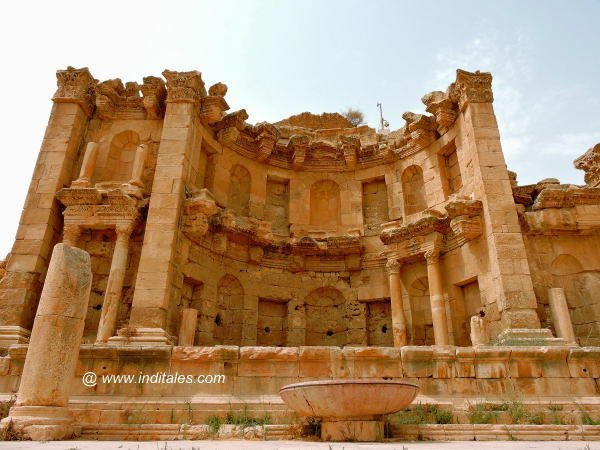
Cardo Attractions
While walking on the Cardo, some of the attractions to stop by include a Cathedral, a church, and two bridges over the Chrysorhoas River. The river along with the city was built, and various public bathhouses and shops towards the south end of Cardo. However, the cherry on this cake is the temple of Nymphaeum. That came up to satisfy the water needs of the city of Gerasa and is hence a huge fountain. Richly decorated, this temple had a marble and stucco facade, though all you can see now is stone.
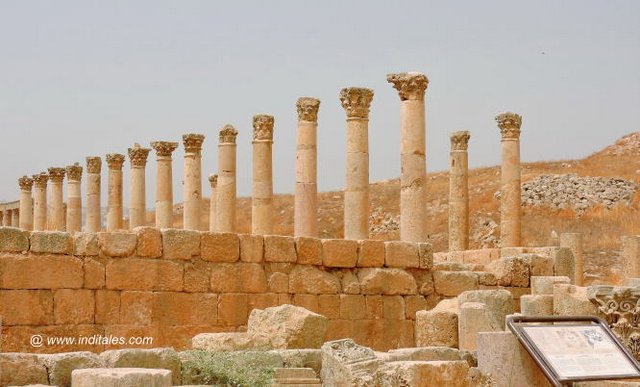
Jerash is a city that is in ruins yet somewhere complete in itself, with most of its elements intact. I failed to see an average house there, no one even mentioned houses, which I assume are the basic unit of a city. They probably lie in some part that is yet to be excavated. I missed visiting the on-site archaeological museum – or perhaps that would be my reason to return to the heritage city one day.
Practical Tips for Visitors
- There are no shaded areas, so going as early in the morning would help.
- Cover your head.
- Be prepared to walk a lot. The walk back would seem much longer than you realize.
- Carry a lot of water, you can feel dehydrated very soon and there is no place to buy water inside the archaeological site.
- I suggest spending a full day there, but half a day is the minimum requirement.
- Just outside the site, there is a buzzing market selling all kinds of curios and souvenirs. This is also the place where you can buy water or other drinks to hydrate yourself.
Recommend you to read the following Jordan Tourist destinations on the Travel Blog.
Visit Jordan – My First Impressions
Top 15 Jordan Souvenirs to Pick
Hejaz Railways – Heritage Rail of Jordan
Amman Citadel – History of Jordan in a Nutshell















Jerash was indeed a bonus…! Great post detailing this hidden gem..
Thanks Ekta. I really want to explore Jerash at leisure on a day that is not as sunny when pictures can come out better and when I can move around easily.
Very nice post, and sounds like a fascinating city. Even from the ruins, all these structures look like they must have been quite magnificent in their majesty. The Oval Forum looks particularly grand!
Aditya, it is an absolutely fascinating place – best preserved ruins if I can use the oxymoronic term. Oval Forum is majestic and I still wonder what it’s purpose might have been.
In the Roman Empire, these forums used to be kind of the city centre or CBD– Roman Forum (Foro Romano) in Rome for example was the main activity centre of Rome, and had the Senate, the public speaking podium (where Julius Caesar, for example, used to make his speeches from, and from where the famous Brutus, Mark Antony (Marcus Antonius) speeches were made from), the most important temples (including the ones in which the main priests would study the entrails of the sacrifices and make the prediction of the day) etc were. The Roman Forum is just next to the main ampitheatre– the Colosseum where the public events used to be, the main baths and a few markets. The commemoration arches are also very close to the Roman Forum. Look at a map of Ancient Rome and it would be very clear to you. I have seen very similar planning with the forum at the centre of a city’s main activity in the ancient sites of Pompeii and Herculaneum (Ercolano) [Pompeii being a huge site, has a few mini fourms as well, which I guess were places for congregation]. I would think, if you looked at the geography of ancient Jerash, you might find a similar planning with the Oval Forum at the centre of activity with the major temples, and activity (offices, ampitheatre etc) surrounding it.
Will read Aditya, before I travel to the next Roman city. What you say makes a lot of sense…it does appear to be an open space for public rituals.
Anu, its so amazing how a small country like Jordan packs such a big punch. While Petra is exciting, it has a lot of other things to offer as you mention.
Bhaven, I was bowled over by the hospitality of the people on the street and in Bedouin Tents. Jerash was a total surprise for me, and will remain my most cherished memory of Jordan.
Loved your post, Anuradha.
The only Roman remains I have seen are in the United Kingdom and they are, of course, not the best specimens of their architecture. I have seen many photographs, yours included, of Jerash and have never failed to be awed by them.
It’s a shame about the heat and the timing of your visit. That’s what second visits are for. Take me along when you go 🙂
Thanks Sudha.
I also saw Roman Baths in Bath UK, but then they are just Baths and not really a whole city.
Honestly, none of the pictures do justice to Jerash. Specially mine because we went at perfectly wrong time for photography. It is also one of the sights where no camera can match the scale of human eye.
Do you want to plan a Roman holiday? Am Game.
Was just there! It was amazing!!! And we were free to walk and climb without being bothered by people hawking their wares! Incredible how it has survived!
True Rachelle – it is fun to walk if the Sun is a bit benevolent. There is a market there so I guess you can shop at will there.
On my visit, I know what I will be observing in these ruins! I am definitely going to check the oscillation of the Corinthian columns. 🙂 Found this to be very fascinating…
Jerash is the most beautiful heritage site of Jordan. I liked it even better than Petra.